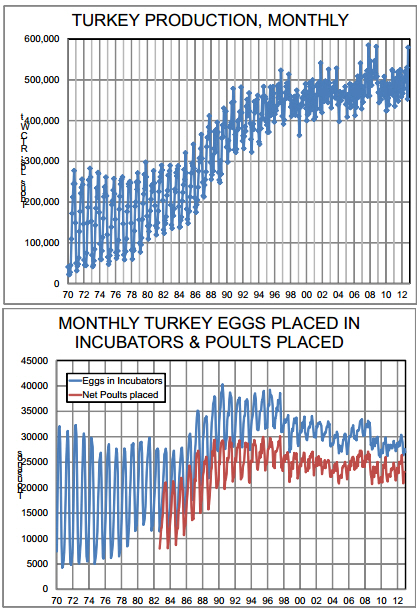



CME: Slaughter Days Affect Poultry Supplies
US - Poultry supplies in October were higher than a year ago but this was largely due to a significant difference in the number of slaughter days available in the month, writes Steve Meyer and Len SteinerLast October there were 21 weekdays and 5 Saturdays while in
October 2012 there were 23 weekdays and 4 Saturdays. Keep this
in mind when looking at the monthly slaughter and production
data.
The latest government statistics show that total US broiler
slaughter in October was 745.9 million head, 6.3% larger than a
year ago.
However, when you convert the monthly number on a
per slaughter day basis, broiler slaughter in October 2012
was down 2.9% from the previous year.
October 2012 broiler
production on a Ready-to-Cook (RTC) basis was estimated at 3.335
billion pounds, 7.7% larger than a year ago.
Converted on a weekday basis, data shows this October we had a daily production of
145.0 million pounds compared to a daily production of 147.5 million pounds last year, a decline of 1.7%. One item that does not get
affected by the difference in available slaughter days in a given
months are broiler weights.
The data shows that producers continue to bring heavier birds to market. In October 2012, the average live weight of broilers coming to market was 5.95 pounds per
bird. On a RTC basis, the weight was 4.47 pounds per bird.
These
bird weights are up 1.1% from the previous year and represent all
time record highs. Turkey production (RTC basis) in October was
579.7 million pounds, 10.5% higher than a year ago. Daily weekday turkey production at 25.2 million pounds was 0.9% higher
than a year ago.
Daily production was higher despite fewer turkeys coming to market than a year ago. Daily turkey slaughter of
about 1.085 million birds per day was down 2% from last year but
sharply higher bird weights more than offset the decline in actual
slaughter. Live weights for turkeys in October were 29.01 pounds,
up 2.4% from last year.

Behind the monthly statistics there is a point which we
think is important. Often the data that gets a lot of press is the
number of eggs set in incubators or poults placed on feed, numbers
that are seen as proxy of future production levels.
And to a certain
extent that is true. However, the broiler industry has been able
for at least the last 20 years to manage an almost straight linear
growth in the weight of birds coming to market (see chart).
If anything, that growth has accelerated in the last few months as feed
costs have increased. Even as the industry has reduced the capacity in terms of birds that are raised in a given month, it has been
able to make up for some of the lost tonnage by increasing efficiencies via the size of the birds coming to market. While month to
month there is significant variation as to the supply of poultry
coming to market the 12-month moving average of broiler production currently is close to the levels we saw before the financial crisis (and resulting industry contraction).
This production
has recovered even as overall slaughter remains well below the
record highs of 2007-08. While producers will likely contain
egg sets and placements in the coming months, it is likely
weight increases are here to stay, and will help offset some of
the reduction in slaughter levels.








